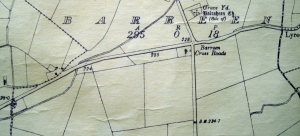The Lady in White
Published in Le Chéile, December 2006
The story of the ‘Lady in White’ dates from around 1860 and occurred at time when farm produce was transported to Dublin by horse and cart. Dairies at the time were sited in the city, as it was easier to produce fresh milk in Dublin rather than from the surrounding rural areas. Because of this hay and straw was transported from rural areas like Clane and Rathcoffey into the city.
Our story involved a local farmer named Pat Gill who lived about two miles north of Rathcoffey and he transported produce from his farm directly to Dublin at this time. The route he took was a road taken by many from the Donadea – Rathcoffey area by way of Baltracey cross-roads to Lady’s Chapel and on to Celbridge. This road hasn’t changed much from that period apart from the construction of a new Church at Lady’s Chapel in 1863. At the time the road was not as busy as it is now and was used mainly by horse-drawn traffic and pedestrians.
On the evening in question Pat with his load of country produce, which included hay, set out for Dublin. He left the main road at Baltracey cross-roads and headed for what is now known as Lady’s Chapel cross-roads. Pat made a comfortable seat for himself on the cart and had plenty of hay about him and under him. It is likely that he had planned to have a snooze while travelling on this quiet section of road. This was not unusual at the time, as the horse having travelled regularly on the route knew the way.
As Pat was passing Baltracey Mill which is situated half a mile from the cross-roads he was pleasantly employed thinking of nothing in particular, dozing and giving an eye to the proceedings of his horse. Then at a point half way between the Mill and Barreen cross-road he was suddenly startled by the appearance of a woman dressed in long white clothes, crossing the fence and advancing onto the road. She came up to the horse and walked on with him close by his neck. Pat pulled the rains on the horse’s head to the opposite side of the figure, for fear the animal should tread on her feet or long robes, but she still kept as close to him as before and sometimes he though he could see the lower part of the horse’s fore leg through her dress. The matter had now become very serious. He could not keep his eyes off the apparition and he felt his whole body covered with a cold perspiration. He became bewildered and could not determine either on going on or stopping. So, the horse finding matters left to himself jogged on apparently unaware of his fellow-wayfarer. The centre of the cross-roads at Barreen had a patch of green in the middle and traffic would pass on either side. When Pat came to its edge, the white figure stood still, while a portion of the shaft of the dray on one side seemed to pass through her. Pat, observing this, pulled the reins on the horse’s head to the other side and cried out in a tremulous voice “By your leave ma’am!” On went the horse and cart, the edges of the load preventing him from seeing the white form. Having advanced two or three yards, he looked back fearing to see a mangled body on the road behind him, but he saw, instead, the white appearance standing in the centre of the plot of grass, her hand seeming to shade her eyes, as she looked earnestly after him. Terrified as he was, he never turned his gaze till a bend in the road.
Who or what was the apparition? The apparition occurred close to a spot where some sixty years before a horrible event occurred, the execution of a woman convicted of cannibalism inflicted on young boys. The apparition was certainly a Lady and she appeared to be looking for someone and it may have been connected to the cannibalism incident. One likely explanation is that the Lady in question was the Mother of one of the unfortunate boys who was the victim of the wicked woman. It is likely that she lived where the apparition appeared and accompanied the horse and cart to the cross-roads and waited there anxiously looking or waiting for her son. The cross-roads is only 150 meters from the site of the cannibalism crime.
Pat Gill’s story of the ‘Lady in White’ was widely spoken about in the area and in 1862 it was submitted with other country stories referred to as ‘treasured lore’ to the editor of Dublin University Magazine. In 1891 it was published in London and New York by MacMillan in ‘Legendary Fictions of the Irish Celts’ by Patrick Kennedy. The patch of green is no longer in the centre of the cross-roads at Barreen. Baltracey Mill was closed down in the early 1870s about ten years after the incident. Today it is a vacant shed alongside the road.
A recent twist to the story emerged following the Halloween meeting of Clane Local History Group in October. The story was one of the ghost stories featured at the meeting and subsequently a resident from Baltracey who lives close to the spot where the ‘Lady in White’ initially appeared, heard the story and disclosed that she was not surprised at it, as she has regularly experienced an unexplained presence at the spot.
Throughout the years the story of the ‘Lady in White’ has appeared in various publications and although there have been substantial changes in society and also considerable changes in the locality the mystery continues to fascinate a curious public. It is obvious that in 2006 the story not only lives on but the spirit of the ‘Lady in White’ continues to exist.

